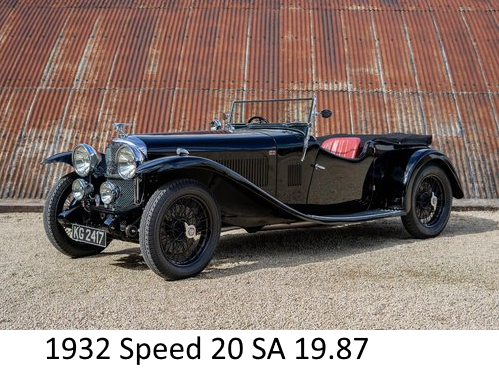Speed 20 SA Description
This type was developed during 1931 to compete with other manufacturers who were marketing "Sports Cars", a new thing at the time. Previously such cars were "Sporting Cars" and were hotted-up versions of standard products. The new "Sports Cars" were built on double-dropped frames and designed for out and out speed and sporting purposes and other competitors were SS, Lagonda, Invicta and MG to name just a few.
Apart from the engine, which was a development of the 20hp Silver Eagle unit the rest of the car was all new and designed for the purpose instead of being converted from something else. The 2511cc 73 x 100mm engine was suitably tuned up with the aid of a "hotter" camshaft and a new cylinder head. A central change gearbox was used along with the Company's latest patented "floating cam" brake system. With 85 BHP on tap and good brakes the car was an instant success.
By 1932 the chassis could be ordered with saloon coachwork and yet another new type of car came into being; The "Sports Saloon", which started a vogue which has persisted up to the present day.
Due to active marketing by the London dealer, Charles Follett, the new Speed Twenty, with its good looks, became very fashionable in society and it had the performance to match. Glancing through the names on the Guarantee Cards is like reading Who's Who: Sir Henry Birkin, Viscount Clanfield, The Countess of Dumfries, Lord Newport, Jimmy Nervo, Lester Matthews, Lord Waleran and the Duke of Westminster to name but a few.
The SA 19.82hp Speed Twenty is a hard, rough and tough machine which made a name for itself early on by being capable of achieving "90 mph from 2½ Litres". This was a revelation at the time and several cars competed at Brooklands as well as taking part in rallies. The SA was succeeded in late 1933 for the 1934 model year by the SB type which brought more refinement and technical innovation to the model at the expense of extra weight. It was the SA which restored the Company's fortunes and gave them a good lead which set them on course out of the economic depression of the period.
The first 26 cars were pre-production models and varied considerably in specification and were not built as a "batch". The chassis numbers are inserted between Silver Eagles, 12/50s and 12/60s. The original prototype, chassis 9184 was registered by the Works as VC 9605 and carried an unusual engine number "EXP 1.6". This car was not sold in its original form, being bodied with a Cross & Ellis tourer and used for the Autocar Road Test. It was subsequently rebuilt by the Works, fitted with a new production engine and rebodied with a Charlesworth fixed-head coupe. The car was used by W.A. Scott-Brown for rallies with a new registration number KV 1577 before being sold.
Speed 20 SA SA 19.82

The engine for the Speed 20 was a heavily modified version of the one used in the preceding Silver Eagle cars, producing 87 bhp (65 kW). Triple HV4 type SU carburettors were fitted. As before the engine and clutch unit sat on flexible conical rubber mountings in a system used by Alvis from 1925. The chassis was new and lowered by making it a "double drop" type where the side rails go up and over the front and rear axles. A centralised lubrication system was fitted allowing oil to be provided to moving suspension parts through a maze of pipework. Both front and rear suspension used half-elliptic leaf springs and the self-servo brakes, with 14 in (356 mm) drums, were mechanically operated. The four-speed manual crash gearbox was mounted in-unit with the engine.
The car could be fitted with a variety of coachwork. Standard bodies were a four-door sports saloon from coachbuilders Charlesworth, a four-seater sports coupé or four-door tourer by Cross & Ellis, but some cars were supplied in chassis form and carried bodies by coachbuilders such as Vanden Plas, who produced a two door tourer and other styles.
Approximately 400 of the SA cars were made.